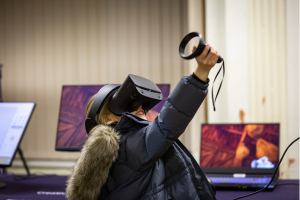19 Virtual Reality
Carrie Lewis Miller
Learning Objectives
- Define Virtual Reality
- Identify options for integrating VR into learning environments
Virtual reality (VR) is similar to virtual worlds in that a user enters an immersive environment similar to real-life through the use of technology. However, unlike virtual worlds, virtual reality environments require special equipment, such as the Oculus Rift Goggles, in order to tap into sensory input. Goggles, helmets, gloves, haptic chairs, or sensors are placed on a user’s person in order to fully immerse them in the virtual environment as shown in Figure 11. In education, virtual reality has yet to become mainstream for a variety of reasons including the cost of equipment. Google has launched Google Expeditions in combination with Google Cardboard, a device that turns any Android phone into VR goggles. Google Expeditions allows users to go on virtual field trips and experience the world right from their classroom. Sadly, Google Expeditions will be discontinued as of July 2021, but the created Expeditions will be saved to the Google Arts and Culture site.

Figure 11: Archeology student wearing VR goggles. Wessex Archeology. (Photographer). (2020, February 5). Archeology in Virtual Reality! [digital image].
Virtual reality has been used to train medical students on specific medical procedures (Labovitz, & Hubbard, 2020; Sattar et al., 2020); business students on presentation skills (McGovern et al., 2020); physics students with experiments (Pirker et al., 2020); and developing language skills or learning to present evidence to a jury (Hurrell & Baker, 2020). These studies have shown higher levels of student engagement and participation when learning in VR environments and some have even shown higher learning gains, particularly in the application of skills outside of the VR environment.
References
Hurrell, C., & Baker, J. (2020). Immersive learning: Applications of virtual reality for undergraduate education. College & Undergraduate Libraries, ahead-of-print(ahead-of-print), 1–13. https://doi.org/10.1080/10691316.2020.1796879
Labovitz, J., & Hubbard, C. (2020). The use of virtual reality in podiatric medical education. Clinics in Podiatric Medicine and Surgery, 37(2), 409-420.
McGovern, E., Moreira, G., & Luna-Nevarez, C. (2020). An application of virtual reality in education: Can this technology enhance the quality of students’ learning experience? Journal of Education for Business, 95(7), 490-496.
Pirker, J., Holly, M., & Gütl, C. (2020, June). Room scale virtual reality physics education: Use cases for the classroom. In 2020 6th International Conference of the Immersive Learning Research Network (iLRN) (pp. 242-246). IEEE.
Sattar, M., Palaniappan, S., Lokman, A., Shah, N., Khalid, U., & Hasan, R. (2020). Motivating medical students using virtual reality based education. International Journal of Emerging Technologies in Learning (iJET), 15(2), 160-174.

